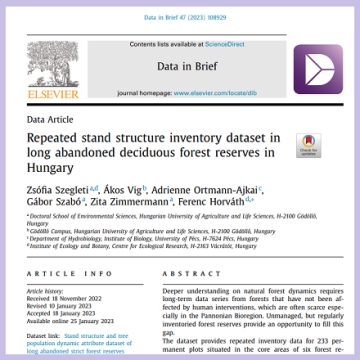A deeper understanding of natural forest dynamics requires long-term data series from forests that have not been affected by human interventions, which are often scarce, especially in the Pannonian Bioregion. Unmanaged, but regularly inventoried forest reserves provide an opportunity to fill this gap.
We tested the re-inventory method at 233 permanent plots situated in the core areas of six forest reserves selected from primary forests (Kékes), long abandoned woods (Kecskés-galya, Szalafő, Várhegy), and abandoned ones (Hidegvíz-völgy, Nagy Istrázsa-hegy). The sampled old stands represent Hungary's four most widespread hilly forest types: Carpathian sub-mountainous beech forest; sessile oak-hornbeam forest; Turkey oak and sessile oak forest; downy oak forest. In each plot, stand-level attributes included main mensuration variables (canopy closure, stand height, tree density, basal area, living and dead volume, lying deadwood, and admixture of the main tree species). Tree level attributes (diameter at breast height, height measured and estimated, crown position in the canopy, health status, tree history of all trees or shrubs having diameter larger or equal to 5 cm) were also measured in two inventories (after 6-16 years) for a total of 6,986 individual trees sampled in all plots. Fagus sylvatica L., Quercus petraea agg., Q. cerris L., Q. pubescens Willd., Carpinus betulus L., Acer campestre L. and Cornus mas L. were the most abundant. The individual tree history classification refers to regeneration ingrowth, growing phase, mortality, decaying phase, and disappearance events, that can be used for the calculation of various stand dynamics attributes.
We prepared and published a Data Paper about the first and re-inventory dataset, that offers valuable opportunities for quantifying changes in stand structures and tree population dynamic attributes after the abandonment of management.
